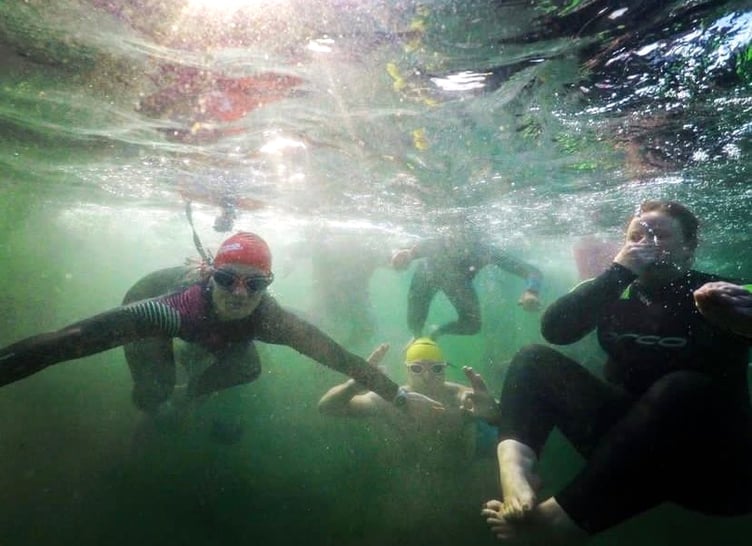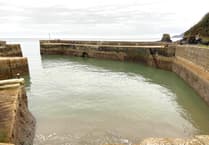Figures from the Rivers Trust have revealed that the number of discharges of sewage across South East Cornwall remain ‘high’, with an average of around ten discharges per day.
Data has also shown that the Town Quay Pumping Station in Fowey has one of the highest number of discharges in the region with a 29% increase on 2021.
Sewage pollution occurs when anything that’s put down the toilet or washed down the drains is released into the environment — this can be through sewer overflow systems, if material is washed off the land and roads, or through poor waste management.
The UK uses storm overflows — also known as Combined Sewer Overflows (CSOs) — within it’s sewage network. These overflows are maintained by water companies, like South West Water.
These overflows are designed to operate automatically during periods of heavy rainfall to protect properties from flooding. They work by discharging untreated but diluted wastewater mixed with clean rainwater back into the environment to take pressure off the network and prevent sewage backing up into homes and drains.
Water companies are permitted to discharge untreated sewage through CSOs under certain circumstances. This process is regulated by the Department for Environment, Food and Rural Affairs (Defra) and the Environment Agency.
Across the region local people have voiced concerns at the amount of untreated sewage reportedly being dumped in rivers and seas.
There were 199 discharges of sewage from Town Quay in Fowey last year.
Adrian Dowrick, from St Austell, told the Cornish Times while fishing in the Fowey estuary with his friend that “sometimes it’s not even worth fishing because of the amount of rubbish in the water and when I do want to fish I don’t want to eat the fish I do pull out.”
South West Water says that there is an issue with sea water getting into the sewer in Fowey which is the reason behind the high number of spills.
The company has said that it is carrying out works within the next year to provide resilience and investigating what improvements are required to bring spills down to a target of 10.
Fowey Harbour Commissioners say that it aspires to have the highest possible water quality in the estuary and will continue to work with all responsible parties to achieve this.
Claire Hoddinott, environment officer for the Fowey Harbour Commissioners, explained: “We do recognise that open water swimming is an incredibly popular activity and swimming takes place all year round.
“Outside of the bathing season, we do recommend that swimmers seek out information about water quality which is available via South West Water’s Waterfit Live service, which provides an interactive map to check local bathing water quality or download the Surfers Against Sewage Safer Seas App.
“In the wider estuary area, we have also been involved with the Environment Agency and SWW to identify and rectify damage and misconnections to the sewerage system, which although individually have a minor impact, cumulatively if left unchecked, they could have a larger effect.”
In 2022, the Health Centre Car Park Pumping Station Emergency Overflow/Cso in Looe had one of the highest number of spills in the town totalling to 103 spills discharging for a total of 448.43 hours — this is a 5% decrease in the number of discharges compared to the previous year.
Guy Cooper, a sea swimmer from Looe, has said that the sewage discharges into the sea where he lives is “disgusting”.
Guy is an active member of the Looe Sea Swimming group, swimming almost everyday, all year round.
He has said that pollution in the sea around Looe “significantly affects group decisions” in deciding whether to take the plunge or not.
He explained: “There’s an app now that’s been going for a number of years that ping’s off sewage discharge and when that does there’s a lot of people who don’t want to go in the water and rightly so.
“It’s an individual’s risk if they want to go. Some of us take that risk and some of us don’t.”
Just around the corner from Looe, lies Seaton beach.
Seaton Pumping Station has seen a 20% decrease in the number of discharges last year compared to 2021, however the hours of discharges totalled 987.11.
Regional representative from Surfers Against Sewage (SAS) and avid water user from Seaton, Marcus Kern, has been helping the marine conservation and campaigning charities’ 30-year campaign for cleaner water for just over a year, however he feels that there is a confusing balance between being active for your health and staying healthy while being active.
Marcus explained: “I’m a big water user. I sail, I surf, I go kite surfing and the information that organisations like SAS puts out as to when certain bathing sites are affected by sewage pollution has an impact on my worry about going in the water.
“There’s certain times when I feel that I don’t want to go in the water when I would like to go because I feel I might get sick and that creates a mental load where you have to constantly worry ‘is this now safe to swim in?’ and that intention of wanting to go into the water versus being afraid against the water is like a dissonance that happens not just with me I think with lots of other people.
“From SAS we encourage people to be in the water because it’s good for you mental well being, it’s a good activity. Whatever you do in the water really is helping your mental state. But at the same time be informed and mindful for when sewage is discharged into bathing waters.”
Tricia Adams, who is also a regular sea swimmer at Seaton, is “cross” about having to repeatedly check the Safer Seas and Rivers Service (SSRS) app operated by Surfers Against Sewage.
The app uses real time water quality and beach safety information to provide alerts for sewage discharges and pollution risks around the UK.
“It’s one of the factors I have to look at before I decide if it’s safe for me to go swimming,” she said.
Tricia explained that after rainfall she is aware that the chances of sewage discharge in the area are high.
She added: “It impacts how often I swim but it hasn’t impacted my health because I don’t swim when it says its polluted.”
Travelling further inland, lies one of Cornwall’s most well known water courses — the River Tamar.
Spanning roughly 61 miles in length, it forms the historic boundary between the counties of Devon and Cornwall and is the platform for the essential Torpoint ferry and Tamar Bridge.
The Tamar runs through the picturesque village of Calstock and is regularly used by Calstock’s gig and rowing clubs.
In the village, the Harewood Road Cso spilled 157 times in 2022 or 709.90 hours, discharging into the River Tamar (Estuarine) — a 10.2% decrease compared to the previous year.
Alastair Tinto, parish councillor for the Calstock Ward, has lived in the area for 40 years.
He is ‘concerned’ about the health of his local river and as a result regularly engages in liaison meetings with water companies and regulatory bodies.
However, back in January this year the parish council submitted a freedom of information request to South West Water (SWW) to gather individual sewage spill data from the 12 sewage overflows in the parish in 2021 — it was reported that this FOI was denied.
Alastair explained: “We can’t get South west Water to give us the data, we know that from the events data that’s provided by Defra every year, we know how many discharges there have been from combined sewer overflows in the parish and there have been 17, so we know for each overflow, we know how many incidents there were in 2022 and 2021 and we know the total number of hours but we don’t actually know when they happened during the year and we know much rainfall there is, we have got the rainfall data for every 15 minutes for the whole of the year.”
The council wanted to use the data to compare with rainfall data to see whether discharges were happening when it was raining or on dry days — this is know as dry spilling and is not permitted.
Alastair continued: “South West Water won’t give us that data because they say it could prejudice an industry wide investigation by Ofwat, the industry regulator. But what we’re saying is, well if there’s nothing to hide why won’t you tell us? And so, for the last nine months, we’ve actually suspended our meetings with SWW because until we get any data that we can discuss with them there hasn’t really been much point in doing that.”
South West Water has reported that they can not comment on specific environmental information requests — the company does not use exemptions to refuse disclosure of environmental information unless there are ‘very good reasons’ to do so.
The water service provider says it’s ambition is to be open and transparent with it’s customers, communities and stakeholders and to share information about the environment.
Both the Environment Agency and Ofwat have commenced investigations into the performance of England’s water sector, where event duration monitoring data, and other data, is undergoing scrutiny.
Just four miles down the road is St Dominick where Extinction Rebellion member and citizen scientist Rebecca Coombes lives.
On behalf of the Rivers Trust, Rebecca has been conducting water testing at Radland brook, which feeds into the Tamar, to help collect essential water quality data which Dr Laurence Couldrick, chief executive officer of the Westcountry Rivers Trust uses to understand how rivers and streams are performing and what is happening upstream.
Dr Laurence explained: “We have used the information where we see particular hot spots where there might need further investigation with more detailed constant monitoring probes, but also establish what the ‘norm’ is for an area and if we need to do work in a catchment to improve the picture.
“The data is also helpful to understand if the river changes after our work.”
However, since Rebecca began testing just over a year ago she has noticed an alarming change within the area.
Rebecca explained: “We moved here in 1993 and the wildlife then, you can’t compare it to today. I’ve seen with my own eyes how these streams are completely dying.
“There used to be little fish, there used to be dippers, kingfishers, herons, we rarely see any of those nowadays.
“I took my children to Cotehele stream to paddle, and people let their dogs paddle, and it’s something you have to think about now, would you let your children go in the water? No, I wouldn’t.”
The St Dominick Wastewater Treatment Works (WwTW) spilled 121 times for a total of 1,136.32 hours, discharging into the River Tamar Estuary in 2022.
The 2022 figures from this waste water treatment works compared to 2021 are very similar with a 0.3% decreased in number of spills and a 1% increase in total hours of discharge.
Rebecca has taken part in an assortment of environmental campaigns with her local Extinction Rebellion group such as a dirty water campaign event in both Calstock and Liskeard, a pollution protest held on Seaton beach and other national campaigns which took place further up country.
Rebecca feels that local councils and MP’s should take the issue “far more seriously” and support the campaigns which she feels the “general public is totally behind.”
She continued: “We have pointed the finger at Sheryll Murray because unfortunately, although lots of people have contacted her, written to her, emailed her, she doesn’t seem to see this as a priority, whereas I think it’s very, very important, so I would like to see local councils, Cornwall County Council, our MP’s take this far more seriously and actually influence the national government to take action.”
Ms Murray has been contacted by the Cornish Times for comment.
South West Water have said that they are “working tirelessly to make improvements” and are “investing record amounts” to reduce the impact on rivers by one-third by 2025 and the use of storm overflows.
A South West Water spokesperson said: “We have committed to eliminate storm overflows at bathing waters by 2030, ahead of the Government target. All of the storm overflows referenced are due to be investigated or have improvements planned to reduce spill numbers.
“We’ve now installed monitoring on 100% of our storm overflows, helping us to target investment where it is most needed.”
The company also said they will be investing £1-million at Seaton and £500,000 at East Looe to make improvements to the bathing waters.


.jpeg?width=209&height=140&crop=209:145,smart&quality=75)


Comments
This article has no comments yet. Be the first to leave a comment.